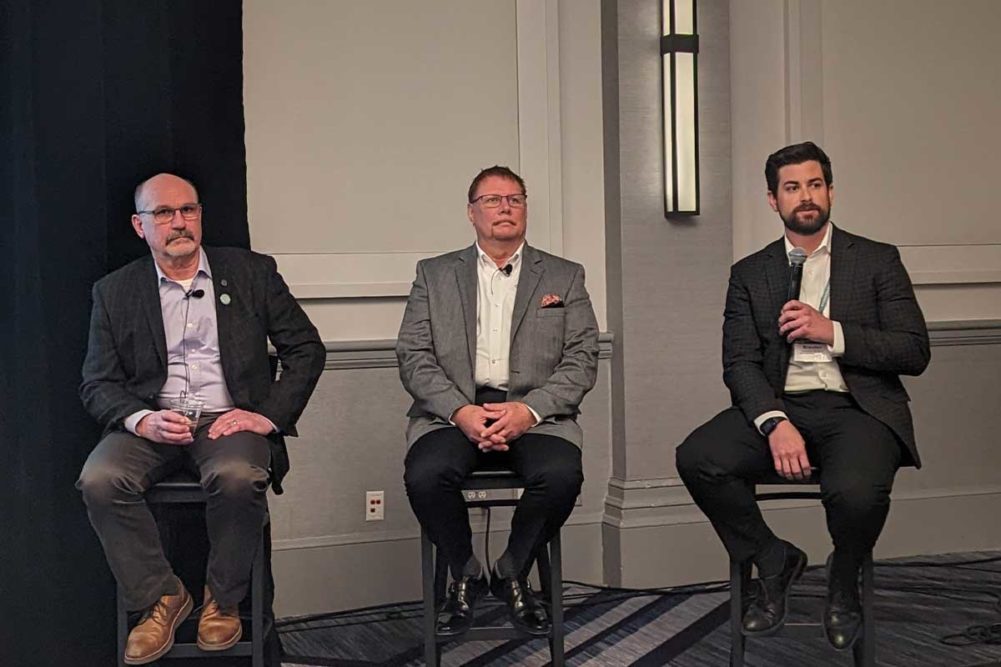CHICAGO — Food safety and sanitation is critical to preserving both consumer safety and a brand’s image. As Jon Anderson, president of JRA Occupational Safety Consulting Services and managing director of the Bakery Equipment Assessment Group (BEAG), pointed out, food safety isn’t a competitive advantage.
“If one company has a problem, it can negatively impact a whole industry,” he said.
Anderson spoke on the importance of hygienic design with co-presenter Randy Kohal, vice president for food safety of Nexcor Food Safety, at the American Society of Baking’s BakingTech conference, held in Chicago, Feb. 27-29. Kohal noted, however, that despite food safety’s importance, sanitation requires time, materials, resources and money.
Facility and equipment design, tools and technology, and even data analysis can help a bakery stay ahead when it comes to sanitation. Tools and technology such as sanitation standard operating procedures and good lighting for visuals can empower a sanitation team to consistently meet sanitation standards. Automated systems can reduce the reliance on labor to clean components such as belting.
“You have to make sure you have the right tools to maintain the standard that you’ve set,” Kohal explained. “When we send people out to do inspections on our equipment, are they able to see well? Do they have the visual capability of inspecting the equipment to make sure they’re able to do a great job ensuring it’s in good condition for production?”
Data analysis can also be a powerful tool, but only if the bakery team is leveraging that data effectively. Simply collecting data and never analyzing it does nothing for a bakery, but it can reveal whether or not a bakery is using its resources effectively and efficiently. Data has the potential to show a bakery team actionable information that can lead to continuous improvement.
“Don’t settle for what you’ve always done,” Kohal said. “Make sure you have data that will allow you to drive for improvement, reduce your cleaning time and give you more production time.”
Equipment that features sanitary design can improve accessibility and make it easier to clean equipment at the microbiological level. BEAG can help bakers certify that their equipment meets the ANSI standards for sanitary design. The ANSI standards are developed by the Z.50 committee, a group of industry professionals that represent both suppliers and bakers. Developed in 1949, the committee has revised the standard as equipment technology has evolved.
“It’s a living document that is always changing,” Anderson explained.
Anderson noted that while protecting consumers is of the utmost importance, regulatory agencies also hold food manufacturers accountable to including hygienically designed equipment in their facilities as a part of their food safety plans. The US Food and Drug Administration (FDA) requires hygienically designed equipment in food manufacturing facilities. Anderson pointed out that if an outbreak occurs, and the FDA determines the food manufacturer is at fault, the agency holds food processors responsible for the equipment in the facility, not the original equipment manufacturer. By certifying equipment with BEAG inspection, bakers add another layer of protection for both consumers and themselves in these situations.
“Not only is it an ethical and moral responsibility for us as food manufacturers and bakers to have equipment in our facilities that clean it easily and efficiently, but we also have some regulations that require us to have it as well,” Anderson said.
BEAG certification requires BEAG membership, applying for internal conformance assessment and having an onsite internal equipment evaluator. Once that is in place, bakers can complete the appropriate equipment assessment form and complete the management of change document if necessary. Once the applications for all applicable equipment are complete, bakers can request a third-party evaluation if they want, however, this is optional.
“The assessment form is an inspection document that allows the internal equipment evaluator to assess and verify that each piece of equipment does conform to the standards,” Anderson said. “People who have gone through this have told me that when they know their equipment conforms to the standard, it’s a very easy document to fill out. But it’s another way for you to say ‘my equipment does conform to the standard.’ … It’s a clean and easy online process to submit and receive your certification.”
While sanitation and food safety is an investment, Anderson and Kohal urged bakers that it’s one they can’t afford to neglect.





